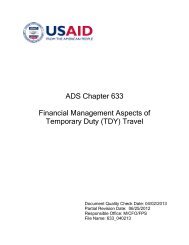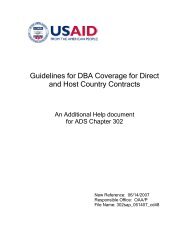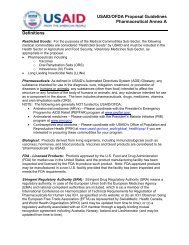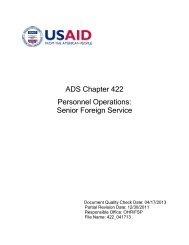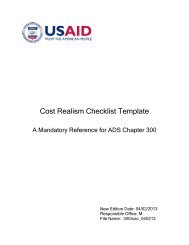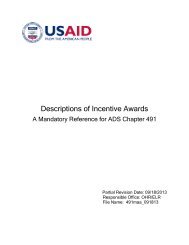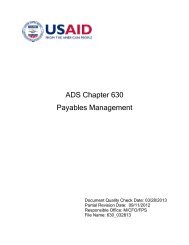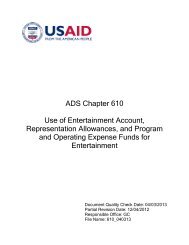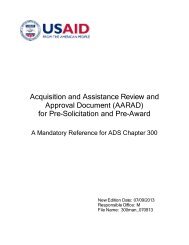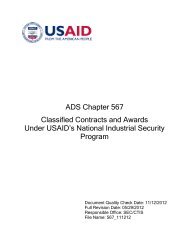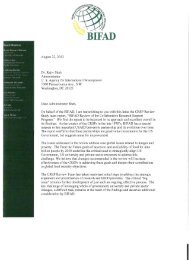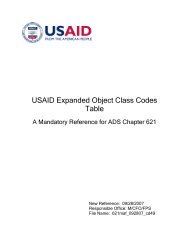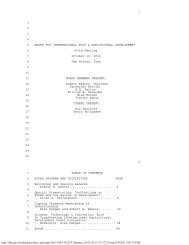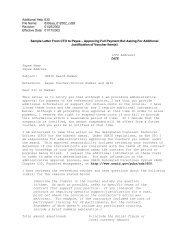USAID Policy Document - Resiliency FINAL 11-26-12.indd
USAID Policy Document - Resiliency FINAL 11-26-12.indd
USAID Policy Document - Resiliency FINAL 11-26-12.indd
- No tags were found...
Create successful ePaper yourself
Turn your PDF publications into a flip-book with our unique Google optimized e-Paper software.
Building Resilience:The Role of Disaster Risk ReductionDisaster risk reduction (DRR) interventions are aimedat reducing the risk associated with specific types ofhazards and disasters. In contrast to general developmentprograms or broader resilience programming,DRR programs focus on potential hazards or shocksand generally target groups that are particularly vulnerableto these hazards and risks. <strong>USAID</strong>’s DRR programsfocus specifically on (1) prioritizing and strengtheningearly warning, preparedness, mitigation, and prevention;(2) integrating preparedness and mitigation with disasterresponse, early recovery, and transitions to foster resilience;and (3) supporting diversified livelihood strategies.For instance, a DRR program might assist a communityliving in a seismically active zone with devising protocolsand procedures to respond to earthquakes or tsunamis.Similarly, a DRR program might assist city planners inflood-prone areas with shoring up rural and urban infrastructureto mitigate the negative impacts of flooding.Resilience, on the other hand, seeks to reduce risk ina broader sense by strengthening the ability of people,households, communities, countries, and systems tocope with both anticipated and unanticipated negativeshocks across a wider range of different areas ofintervention. While DRR programs are central to thegoal of building resilience, they are not sufficient in andof themselves. Becoming resilient requires a range ofapproaches to help communities develop the capacityto manage the range of challenges that threaten stability,whether sudden or longer term, urban or rural,natural or human-made. DRR programs are one partof the solution; to achieve resilience in any given area,a broader concerted and coordinated effort by bothdevelopment and humanitarian actors is required. Theseapproaches should integrate DRR with a diverse combinationof other interdependent activities that contributeto increasing adaptive capacity, improving the ability toaddress and reduce risk, and improving the social andeconomic conditions of vulnerable populations.plots), different sources of incomes, and the capacity to controlthe choice of foods being prepared and consumed are betterable to improve their household’s food security and nutrition. 6Approaches that systematically and visibly reduce key gendergaps and ensure that women are given the tools, resources, andopportunities to lead and participate are critical to the successof our efforts to achieve sustainable change.Source: <strong>USAID</strong>Pineapple pioneer Masum Ahmed showcases his contoured pineapple field inHail Haor, Bangladesh.Functioning institutions of good governance and democraticaccountability are essential to developing a country’s adaptivecapacity and its ability to address and reduce risk. Good governancerequires institutions and processes that are transparent,accountable, and responsive to the people they serve and thatpromote positive state-society relationships (including a strongcivil society and a vibrant private sector). Governance capacitydetermines the ability of the state to respond effectively to crisesand to address the long-term development needs requiredto effectively address recurrent issues. Furthermore, goodgovernance is crucial to prevent and mitigate confl ict, whichplays a detrimental role in many of the communities where weare applying a resilience approach and which has, in past effortsto build resilience, stood decisively in the way of sustainableprogress.Any approach that seeks to build resilience must be informedby confl ict dynamics, as humanitarian need may be great inareas emerging from confl ict or still fragile. Programming thatintegrates confl ict resolution and peace building, and strengthensinstitutions of good governance, plays an important role incontributing to the sustainability of development gains. In fragilestates where these challenges are particularly acute, the NewDeal for Engagement in Fragile States 7 provides both a normativeframework and top-level guidance for focusing the combinedefforts of host country leaders and international donorson inclusive politics and strengthening institutions of governance,which are essential to building states, peace, and resilience.The links between the many important factors required to buildresilience are complex. The challenge is to determine whichinstitutional, policy, and political constraints pose the most signifi -cant impediments to building resilience and which are amenable6 Ibnouf, Fatma. “The Role of Women in Providing and Improving Household Food Security in Sudan: Implications for Reducing Hunger and Malnutrition.” Journal of InternationalWomen’s Studies, Web. http://www.bridgew.edu/soas/jiws/May09/SudanFoodSecurity.pdf.7 Find more information on the New Deal for Engagement in Fragile States at http://www.aideffectiveness.org/busanhlf4/about/new-deal-for-engagement-in-fragile-states.html.12



